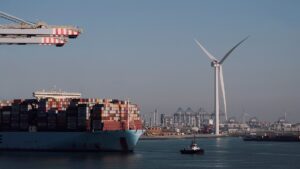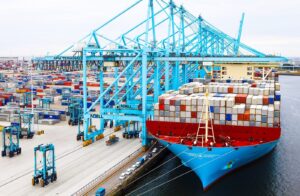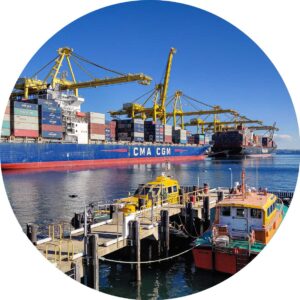Spin offs and Economic Benefits of Ports in Pakistan
A seaports economic impact stretches far beyond ports limits. Taking into account the direct and flow-on effects of trade entering and leaving the port area the added value supports a port cities businesses, communities and its people. Local Government Areas and the communities adjacent to the port are the prime locations that reap the benefits of output (gross revenue of total expenditure), value-addition including payments to labour and capital , and contribution to household wage income amply depicting a port’s role as a key economic stimulant.Port expansion projects enable export diversification which in turn attracts foreign direct investment and the integration into regional and global value chain . Unfortunately gender disparity in maritime is high as women occupy only 18% of port jobs in the year 2021.
Containerised Trade and Foreign Investment and Tax Revenues
Presently around 80 % of global merchandise trade (by volume) is transported via sea routes out of which almost 35 % of total volumes and over 60 % of commercial value of goods is carried in containers. Container ports are essential nodes in global supply chains and are crucial to the growth strategies of many emerging economies . Seaway transportation is the cheapest and most effective transportation system compared to other systems. A port is a point of transport modal transfer from sea to land or land to sea, or sea to sea in the case of transshipment although in case of transshipment the containers invariably land on the key apron prior to being loaded again to the ship.
In the US seaports just 3-4 years back generated direct and un direct employment of nearly 31 million people in the United States. By a rule of thumb for every $1 billion in exports shipped through U.S seaports around 15,000 jobs are created. Cargo activities at U.S. seaports account for 26 % of the U.S. economy, generating nearly $5.4 trillion in total economic activity and more than $378 billion in federal, state and local taxes in 2018.
The development of high-quality port infrastructure, operated efficiently, has often been a prerequisite for successful growth strategies particularly those driven by exports and it fosters confidence to attract investment in production and distribution systems, supporting growth of manufacturing and logistics, creating employment and increasing income levels.According to the Economic and Social Commission for Asia and the Pacific (ESCAP) the Netherlands has been able to sustain a relatively decent economic growth rate because of the Port of Rotterdam in spite of a fiercely competitive environment in Europe. A paradox exists that the regions served by the port of Mombasa , Kenya are amongst the poorest region in Kenya. On the other hand Tanzania has 22 ports, 3 of which are major ports (Dar es Salaam, Mtwara, and Tanga) and 19 small ports. Tanzania’s ports serve as a vital gateway for international trade in East and Central Africa and Tanzania is investing and upgrading its port infrastructure and it serves landlocked African countries .Tanzania’s GDP is increasing at an annual rate of 7 %.

Credit : UNCTAD
Ports and Economies of Landlocked Countries
On a more technical side Landlocked Developing Countries access to seaports is critical. In the case of Afghanistan and Central Asian states like Tajikistan, Kazakstan and Uzbekistan which are developing and expanding economies and also recently opening economies access to seaports is integral to their development . Thus efficiently operating ports along with the corresponding access infrastructure such as inland waterways, railways and road network to the hinterland remain the vital links to the global marketplace . Efficient performance incorporates several factors, such as port’s efficiency , availability of sufficient draught, quay and dock facilities, quality of road and rail connections, the competitiveness of these services and the effectiveness of the procedures utilised by public agencies for container clearance.
 Credit: Container News
Credit: Container News
Australian Ports Benefit Business
Port Botany is one of Australia’s deep water port and its largest container port and integral to Australia’s national economy. Almost 2.5 million containers (TEUs) pass through Port Botany annually . Port Botany is the only port in Australia with on-dock rail at its container terminals and recently Patrick Terminals saw private sector investment of around $190 million establishing a framework for rail infrastructure and intermodal terminal delivery in Sydney . Importers and exporters in Australia are the direct beneficiaries as the port and its three container terminals are connected by a dedicated freight rail to a network of intermodal terminals .
 Credit ; Port Authority of News South Wales
Credit ; Port Authority of News South Wales
Pakistan’s Seaports a Game Changer for Central Asian Countries, Afghanistan and China
What is happening is that instead of facilitating trade ports are increasing the cost of imports and exports and drastically slowing the global circular system of container shipping as ships have to wait unnecessarily incurring additional fuel costs, demurrage payable in foreign exchange , additional fuel costs which in turn lead to harmful emissions.
The seaports of Pakistan on a war footing need to reduce inefficiencies or non-tariff barriers which result in higher costs, reduced competitiveness and lower trade volumes.Improving container port performance lowers the cost of trade, contributes to food and energy security, improves resilience, and reduces unnecessary emissions from vessels. Higher throughput of goods and passengers requires investment in infrastructure, associated services and generates employment.The hinterland is a beneficiary as they serve as a crucial connection between sea and land transport. Industries require a safe and cheap means of exporting finished goods and importing raw materials. Industrialised nations have their industrial hubs located in the coastal belts in the close proximity of ports. The role of the private sector in the development of ports is essential as ports are strategic and valuable assets as demonstrated in development of the worlds largest trans-shipment port of Singapore.
Running Pakistan’s seaports efficiently will significantly lower the cost of doing business in Pakistan , spur economic growth, lead to sustainable development and make the seaports an integral component of the China Silk and Belt Initiative and the Chinese and Central Asian countries economic and logistics corridor to the world. The ports of Pakistan have huge estates and potential for establishing of exclusive economic zones .Such reforms in the maritime sector will make Pakistan’s seaports a destination for Foreign Direct Investment as well . Its time for Pakistan to get its act together to regain its position as a regional maritime and logistic hub.
Authored by Nadir Mumtaz
Sources/Credit
https://journals.sagepub.com/doi/pdf/10.1177/21582440221145894
https://www.aapa-ports.org/advocating/content.aspx?ItemNumber=21150
https://blogs.worldbank.org/transport/why-ports-matter-global-economy
https://www.sciencedirect.com/science/article/pii/S2214241X15000413
https://unctad.org/news/why-ports-are-heart-sustainable-development

Well delivered indeed development of CPEC would help in economic growth and hope improved GDP & GNP so country flourishes
Excellent writeup. Pakistan needs to prioritize this sector.